5 must-see birds in the Galapagos
Bird watchers who want a luxury vacation should set their sights on the Galápagos Islands. To fully appreciate these islands remote beauty, arrive on a luxurious cruiser. You can find beautifully appointed tour boats that provide ample space on deck for bird watching (as well as sunbathing, swimming in the built-in swimming pool, and sampling tropical cocktails).
The birds of the Galápagos offer a window into the biodiversity that has made this archipelago famous. 80 percent of the birds here are not found anywhere else in the world. Because of the absence of predators in the Galápagos, these birds are relatively easy to spot and photograph.
Below is a list of birds that youre unlikely to see outside of the Galápagos, along with the island where youre most likely to spot them. You can see some of the following birds on more than one island, but they tend to favor one island as their breeding ground.
1. Blue footed boobies on North Seymour Island
Blue-footed boobies have a floppy mating dance that initially earned the derision of 16th-century Spaniards. They named them bobos, which translates to dummies in English. It didnt help that the blue-footted boobies were quite easy for the Spaniards to catch these types of birds cannot move quickly on land, and have no predators in the Galápagos.
 Both the males and females have blue feet, but only males perform courting dances. Female birds are looking for the males with feet that are the brightest shade of blue. Once the female booby lays the eggs, the parents take turns straddling the eggs with their feet to keep them warm.
Blue-footed boobies spend most of their lives out at sea. They can spot tasty anchovies from as high as 80 feet (25 m). Their dives are so precise they barely make a splash when they enter the water.
2. Frigatebird on North Seymour Island
On North Seymour Island you can see two species of frigatebirds: the magnificent frigatebird and the great frigatebird. Female frigatebirds of both varieties have black and white feathers. Male frigatebirds are black, but male great frigatebirds have a green sheen to their black feathers, while male magnificent frigatebirds are more purplish.
Both the males and females have blue feet, but only males perform courting dances. Female birds are looking for the males with feet that are the brightest shade of blue. Once the female booby lays the eggs, the parents take turns straddling the eggs with their feet to keep them warm.
Blue-footed boobies spend most of their lives out at sea. They can spot tasty anchovies from as high as 80 feet (25 m). Their dives are so precise they barely make a splash when they enter the water.
2. Frigatebird on North Seymour Island
On North Seymour Island you can see two species of frigatebirds: the magnificent frigatebird and the great frigatebird. Female frigatebirds of both varieties have black and white feathers. Male frigatebirds are black, but male great frigatebirds have a green sheen to their black feathers, while male magnificent frigatebirds are more purplish.
 Male frigatebirds have red sacks on their chests that they inflate to attract mates. As they inflate the red sac they also vibrate their wings. After mating, the males bring their mates materials to build nests. Mangroves are one of the preferred areas for nesting. Once the female finishes building the nest, the male frigatebird begins his role as the nest protector. He tilts his head back and puffs out his chest, and cries out a warning sound to other birds that might consider approaching.
Frigatebirds are seafaring birds that can eat a wide variety of Galápagos wildlife. Small fish, jellyfish, turtle eggs, crustaceans, and baby birds of different species are all on the menu. They dont dive, but instead nip their prey from the surface of the water. These birds also get food by harassing other birds once their unlucky target drops their prey, the frigatebird swoops in to steal it.
3. Flightless cormorant on Fernandina Island
The flightless cormorant lives primarily on the shores of the Fernandina Island, but you can also see it on the north and west coast of Isabela Island. Close to the shore, the birds venture into the water to hunt for fish, octopi, and eels.
Male frigatebirds have red sacks on their chests that they inflate to attract mates. As they inflate the red sac they also vibrate their wings. After mating, the males bring their mates materials to build nests. Mangroves are one of the preferred areas for nesting. Once the female finishes building the nest, the male frigatebird begins his role as the nest protector. He tilts his head back and puffs out his chest, and cries out a warning sound to other birds that might consider approaching.
Frigatebirds are seafaring birds that can eat a wide variety of Galápagos wildlife. Small fish, jellyfish, turtle eggs, crustaceans, and baby birds of different species are all on the menu. They dont dive, but instead nip their prey from the surface of the water. These birds also get food by harassing other birds once their unlucky target drops their prey, the frigatebird swoops in to steal it.
3. Flightless cormorant on Fernandina Island
The flightless cormorant lives primarily on the shores of the Fernandina Island, but you can also see it on the north and west coast of Isabela Island. Close to the shore, the birds venture into the water to hunt for fish, octopi, and eels.
 Flightless cormorants are also known as Galápagos cormorants every other species of cormorant found elsewhere in the world can fly. They have stubby wings and comparatively heavy bodies.
Males are larger than females, but their dark gray plumage is quite similar. If you can get close enough to a flightless cormorant, you will notice its one colorful feature its sapphire-colored eyes.
4. Pink flamingo on Isabela Island
On Isabela Island youll find Flamingo Lagoon. It has saltwater and provides a shrimp-rich habitat for this population of around 300 birds. Its a short trip to this lake from the town of Puerto Villamil.
Flightless cormorants are also known as Galápagos cormorants every other species of cormorant found elsewhere in the world can fly. They have stubby wings and comparatively heavy bodies.
Males are larger than females, but their dark gray plumage is quite similar. If you can get close enough to a flightless cormorant, you will notice its one colorful feature its sapphire-colored eyes.
4. Pink flamingo on Isabela Island
On Isabela Island youll find Flamingo Lagoon. It has saltwater and provides a shrimp-rich habitat for this population of around 300 birds. Its a short trip to this lake from the town of Puerto Villamil.
 Pink flamingoes dip their beaks into the muddy bottoms of the lagoon to hunt for small fish, larvae, plankton, and shrimp. They use their webbed feet to churn up the mud and shake loose the small animals that they want to eat. Once they breed they pick out a cozy corner of the marsh to build a nest out of mud.
Flamingo chicks are fluffy and grey, and only turn pink after theyve started eating shrimp.
5. Red billed tropicbird on Española Island
Red Billed Tropicbirds sBird watchers who want a luxury vacation should set their sights on the Galápagos Islands. To fully appreciate these islands remote beauty, arrive on a luxurious cruiser. You can find beautifully appointed tour boats that provide ample space on deck for bird watching (as well as sunbathing, swimming in the built-in swimming pool, and sampling tropical cocktails).
Pink flamingoes dip their beaks into the muddy bottoms of the lagoon to hunt for small fish, larvae, plankton, and shrimp. They use their webbed feet to churn up the mud and shake loose the small animals that they want to eat. Once they breed they pick out a cozy corner of the marsh to build a nest out of mud.
Flamingo chicks are fluffy and grey, and only turn pink after theyve started eating shrimp.
5. Red billed tropicbird on Española Island
Red Billed Tropicbirds sBird watchers who want a luxury vacation should set their sights on the Galápagos Islands. To fully appreciate these islands remote beauty, arrive on a luxurious cruiser. You can find beautifully appointed tour boats that provide ample space on deck for bird watching (as well as sunbathing, swimming in the built-in swimming pool, and sampling tropical cocktails).
 The birds of the Galápagos offer a window into the biodiversity that has made this archipelago famous. 80 percent of the birds here are not found anywhere else in the world. Because of the absence of predators in the Galápagos, these birds are relatively easy to spot and photograph.
Below is a list of birds that youre unlikely to see outside of the Galápagos, along with the island where youre most likely to spot them. You can see some of the following birds on more than one island, but they tend to favor one island as their breeding ground.
Zach Smith is CEO of Anywhere.
If you would like to be a guest blogger on A Luxury Travel Blog in order to raise your profile, please contact us.
The birds of the Galápagos offer a window into the biodiversity that has made this archipelago famous. 80 percent of the birds here are not found anywhere else in the world. Because of the absence of predators in the Galápagos, these birds are relatively easy to spot and photograph.
Below is a list of birds that youre unlikely to see outside of the Galápagos, along with the island where youre most likely to spot them. You can see some of the following birds on more than one island, but they tend to favor one island as their breeding ground.
Zach Smith is CEO of Anywhere.
If you would like to be a guest blogger on A Luxury Travel Blog in order to raise your profile, please contact us.
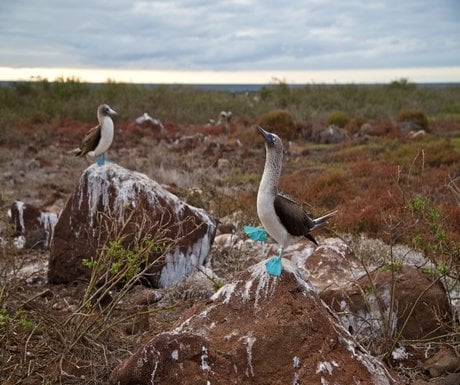 Both the males and females have blue feet, but only males perform courting dances. Female birds are looking for the males with feet that are the brightest shade of blue. Once the female booby lays the eggs, the parents take turns straddling the eggs with their feet to keep them warm.
Blue-footed boobies spend most of their lives out at sea. They can spot tasty anchovies from as high as 80 feet (25 m). Their dives are so precise they barely make a splash when they enter the water.
2. Frigatebird on North Seymour Island
On North Seymour Island you can see two species of frigatebirds: the magnificent frigatebird and the great frigatebird. Female frigatebirds of both varieties have black and white feathers. Male frigatebirds are black, but male great frigatebirds have a green sheen to their black feathers, while male magnificent frigatebirds are more purplish.
Both the males and females have blue feet, but only males perform courting dances. Female birds are looking for the males with feet that are the brightest shade of blue. Once the female booby lays the eggs, the parents take turns straddling the eggs with their feet to keep them warm.
Blue-footed boobies spend most of their lives out at sea. They can spot tasty anchovies from as high as 80 feet (25 m). Their dives are so precise they barely make a splash when they enter the water.
2. Frigatebird on North Seymour Island
On North Seymour Island you can see two species of frigatebirds: the magnificent frigatebird and the great frigatebird. Female frigatebirds of both varieties have black and white feathers. Male frigatebirds are black, but male great frigatebirds have a green sheen to their black feathers, while male magnificent frigatebirds are more purplish.
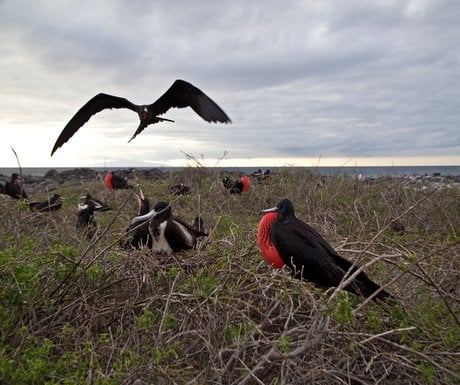 Male frigatebirds have red sacks on their chests that they inflate to attract mates. As they inflate the red sac they also vibrate their wings. After mating, the males bring their mates materials to build nests. Mangroves are one of the preferred areas for nesting. Once the female finishes building the nest, the male frigatebird begins his role as the nest protector. He tilts his head back and puffs out his chest, and cries out a warning sound to other birds that might consider approaching.
Frigatebirds are seafaring birds that can eat a wide variety of Galápagos wildlife. Small fish, jellyfish, turtle eggs, crustaceans, and baby birds of different species are all on the menu. They dont dive, but instead nip their prey from the surface of the water. These birds also get food by harassing other birds once their unlucky target drops their prey, the frigatebird swoops in to steal it.
3. Flightless cormorant on Fernandina Island
The flightless cormorant lives primarily on the shores of the Fernandina Island, but you can also see it on the north and west coast of Isabela Island. Close to the shore, the birds venture into the water to hunt for fish, octopi, and eels.
Male frigatebirds have red sacks on their chests that they inflate to attract mates. As they inflate the red sac they also vibrate their wings. After mating, the males bring their mates materials to build nests. Mangroves are one of the preferred areas for nesting. Once the female finishes building the nest, the male frigatebird begins his role as the nest protector. He tilts his head back and puffs out his chest, and cries out a warning sound to other birds that might consider approaching.
Frigatebirds are seafaring birds that can eat a wide variety of Galápagos wildlife. Small fish, jellyfish, turtle eggs, crustaceans, and baby birds of different species are all on the menu. They dont dive, but instead nip their prey from the surface of the water. These birds also get food by harassing other birds once their unlucky target drops their prey, the frigatebird swoops in to steal it.
3. Flightless cormorant on Fernandina Island
The flightless cormorant lives primarily on the shores of the Fernandina Island, but you can also see it on the north and west coast of Isabela Island. Close to the shore, the birds venture into the water to hunt for fish, octopi, and eels.
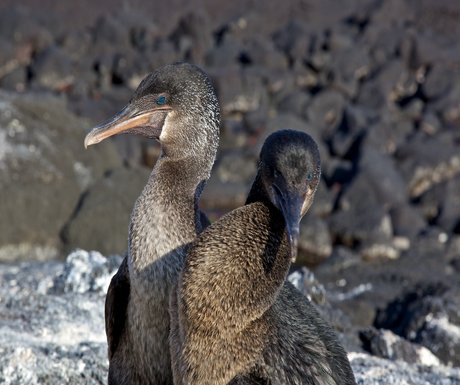 Flightless cormorants are also known as Galápagos cormorants every other species of cormorant found elsewhere in the world can fly. They have stubby wings and comparatively heavy bodies.
Males are larger than females, but their dark gray plumage is quite similar. If you can get close enough to a flightless cormorant, you will notice its one colorful feature its sapphire-colored eyes.
4. Pink flamingo on Isabela Island
On Isabela Island youll find Flamingo Lagoon. It has saltwater and provides a shrimp-rich habitat for this population of around 300 birds. Its a short trip to this lake from the town of Puerto Villamil.
Flightless cormorants are also known as Galápagos cormorants every other species of cormorant found elsewhere in the world can fly. They have stubby wings and comparatively heavy bodies.
Males are larger than females, but their dark gray plumage is quite similar. If you can get close enough to a flightless cormorant, you will notice its one colorful feature its sapphire-colored eyes.
4. Pink flamingo on Isabela Island
On Isabela Island youll find Flamingo Lagoon. It has saltwater and provides a shrimp-rich habitat for this population of around 300 birds. Its a short trip to this lake from the town of Puerto Villamil.
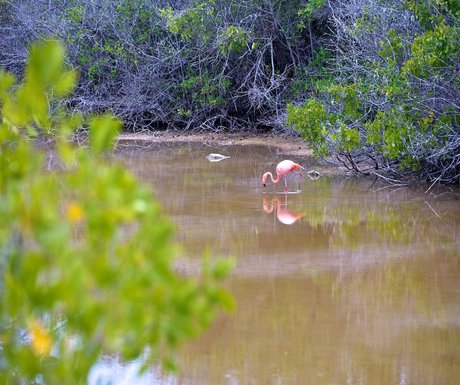 Pink flamingoes dip their beaks into the muddy bottoms of the lagoon to hunt for small fish, larvae, plankton, and shrimp. They use their webbed feet to churn up the mud and shake loose the small animals that they want to eat. Once they breed they pick out a cozy corner of the marsh to build a nest out of mud.
Flamingo chicks are fluffy and grey, and only turn pink after theyve started eating shrimp.
5. Red billed tropicbird on Española Island
Red Billed Tropicbirds sBird watchers who want a luxury vacation should set their sights on the Galápagos Islands. To fully appreciate these islands remote beauty, arrive on a luxurious cruiser. You can find beautifully appointed tour boats that provide ample space on deck for bird watching (as well as sunbathing, swimming in the built-in swimming pool, and sampling tropical cocktails).
Pink flamingoes dip their beaks into the muddy bottoms of the lagoon to hunt for small fish, larvae, plankton, and shrimp. They use their webbed feet to churn up the mud and shake loose the small animals that they want to eat. Once they breed they pick out a cozy corner of the marsh to build a nest out of mud.
Flamingo chicks are fluffy and grey, and only turn pink after theyve started eating shrimp.
5. Red billed tropicbird on Española Island
Red Billed Tropicbirds sBird watchers who want a luxury vacation should set their sights on the Galápagos Islands. To fully appreciate these islands remote beauty, arrive on a luxurious cruiser. You can find beautifully appointed tour boats that provide ample space on deck for bird watching (as well as sunbathing, swimming in the built-in swimming pool, and sampling tropical cocktails).
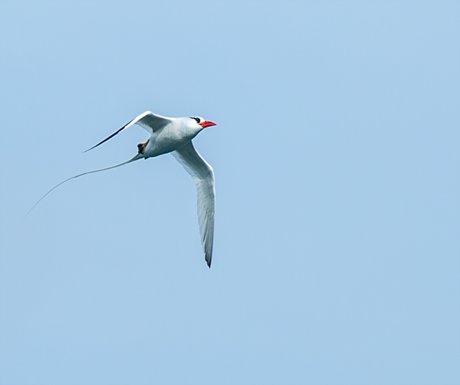 The birds of the Galápagos offer a window into the biodiversity that has made this archipelago famous. 80 percent of the birds here are not found anywhere else in the world. Because of the absence of predators in the Galápagos, these birds are relatively easy to spot and photograph.
Below is a list of birds that youre unlikely to see outside of the Galápagos, along with the island where youre most likely to spot them. You can see some of the following birds on more than one island, but they tend to favor one island as their breeding ground.
Zach Smith is CEO of Anywhere.
If you would like to be a guest blogger on A Luxury Travel Blog in order to raise your profile, please contact us.
The birds of the Galápagos offer a window into the biodiversity that has made this archipelago famous. 80 percent of the birds here are not found anywhere else in the world. Because of the absence of predators in the Galápagos, these birds are relatively easy to spot and photograph.
Below is a list of birds that youre unlikely to see outside of the Galápagos, along with the island where youre most likely to spot them. You can see some of the following birds on more than one island, but they tend to favor one island as their breeding ground.
Zach Smith is CEO of Anywhere.
If you would like to be a guest blogger on A Luxury Travel Blog in order to raise your profile, please contact us.Did you enjoy this article?
Receive similar content direct to your inbox.

